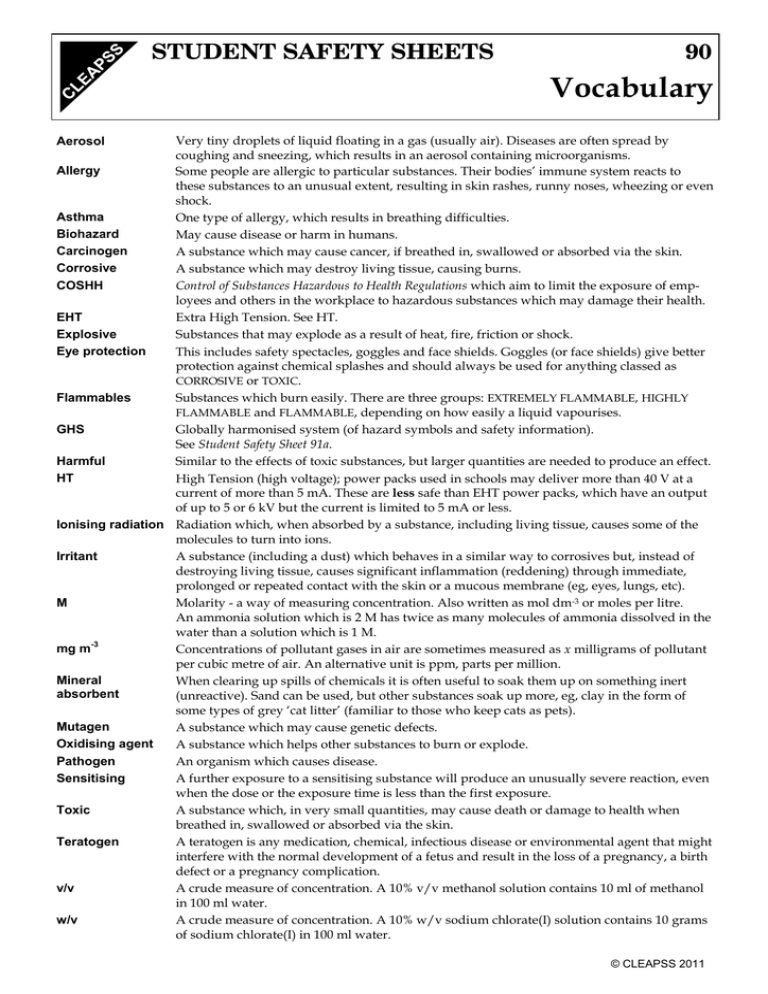Vocabulary STUDENT SAFETY SHEETS 90
advertisement

STUDENT SAFETY SHEETS 90 Vocabulary Very tiny droplets of liquid floating in a gas (usually air). Diseases are often spread by coughing and sneezing, which results in an aerosol containing microorganisms. Allergy Some people are allergic to particular substances. Their bodies’ immune system reacts to these substances to an unusual extent, resulting in skin rashes, runny noses, wheezing or even shock. Asthma One type of allergy, which results in breathing difficulties. Biohazard May cause disease or harm in humans. Carcinogen A substance which may cause cancer, if breathed in, swallowed or absorbed via the skin. Corrosive A substance which may destroy living tissue, causing burns. COSHH Control of Substances Hazardous to Health Regulations which aim to limit the exposure of employees and others in the workplace to hazardous substances which may damage their health. EHT Extra High Tension. See HT. Explosive Substances that may explode as a result of heat, fire, friction or shock. Eye protection This includes safety spectacles, goggles and face shields. Goggles (or face shields) give better protection against chemical splashes and should always be used for anything classed as CORROSIVE or TOXIC. Flammables Substances which burn easily. There are three groups: EXTREMELY FLAMMABLE, HIGHLY FLAMMABLE and FLAMMABLE, depending on how easily a liquid vapourises. GHS Globally harmonised system (of hazard symbols and safety information). See Student Safety Sheet 91a. Harmful Similar to the effects of toxic substances, but larger quantities are needed to produce an effect. HT High Tension (high voltage); power packs used in schools may deliver more than 40 V at a current of more than 5 mA. These are less safe than EHT power packs, which have an output of up to 5 or 6 kV but the current is limited to 5 mA or less. Ionising radiation Radiation which, when absorbed by a substance, including living tissue, causes some of the molecules to turn into ions. Irritant A substance (including a dust) which behaves in a similar way to corrosives but, instead of destroying living tissue, causes significant inflammation (reddening) through immediate, prolonged or repeated contact with the skin or a mucous membrane (eg, eyes, lungs, etc). M Molarity - a way of measuring concentration. Also written as mol dm-3 or moles per litre. An ammonia solution which is 2 M has twice as many molecules of ammonia dissolved in the water than a solution which is 1 M. -3 mg m Concentrations of pollutant gases in air are sometimes measured as x milligrams of pollutant per cubic metre of air. An alternative unit is ppm, parts per million. Mineral When clearing up spills of chemicals it is often useful to soak them up on something inert absorbent (unreactive). Sand can be used, but other substances soak up more, eg, clay in the form of some types of grey ‘cat litter’ (familiar to those who keep cats as pets). Mutagen A substance which may cause genetic defects. Oxidising agent A substance which helps other substances to burn or explode. Pathogen An organism which causes disease. Sensitising A further exposure to a sensitising substance will produce an unusually severe reaction, even when the dose or the exposure time is less than the first exposure. Toxic A substance which, in very small quantities, may cause death or damage to health when breathed in, swallowed or absorbed via the skin. Teratogen A teratogen is any medication, chemical, infectious disease or environmental agent that might interfere with the normal development of a fetus and result in the loss of a pregnancy, a birth defect or a pregnancy complication. v/v A crude measure of concentration. A 10% v/v methanol solution contains 10 ml of methanol in 100 ml water. w/v A crude measure of concentration. A 10% w/v sodium chlorate(I) solution contains 10 grams of sodium chlorate(I) in 100 ml water. Aerosol © CLEAPSS 2011




